Features of Fiji’s Flora and Fauna Currency
Did you know?
The Reserve Bank of Fiji (RBF) on average issues 55 million brand new banknotes into circulation each year to replace worn out and damaged banknotes and to meet demand. Replacing worn out and damaged banknotes is an expensive exercise costing the RBF approximately $2.4 million annually.
You can help save money for the nation by looking after your banknotes, keeping them cleaner and making them last longer.
Tips to care for your polymer banknotes
The RBF for the first time has introduced a new polymer banknote in the $5 denomination. Polymer banknotes require special care. Some tips are:
- Do not staple or pin banknotes. Polymer banknotes tear easily from the holes created by staples or pins. Use paper clips instead. Paper clips don’t damage polymer banknotes.
- Do not expose polymer banknotes to excessive heat such as ironing, heaters and driers. Exposing polymer banknotes to excessive heat could cause them to melt. If melted, you will lose your banknotes and these will be of no value.
Tips to care for your Polymer and Paper banknotes
All banknotes must be looked after carefully to ensure they remain clean and can be used for a longer period of time. Some basic banknote handling tips are:
- Keep banknotes straight to help them last longer. Folding and crumpling damages the banknotes and reduces their life.
- If possible, keep banknotes in wallets and purses. Wallets and purses prevent banknotes from being damaged and also help in keeping them clean.
- Do not apply sellotape on banknotes. Applying sellotape on banknotes damages them and also destroys their look and feel.
- Do not write on them. Writing on banknotes destroys the look and feel of them. Writing on banknotes is also illegal.
- Store banknotes in cool and dry places. Water, moisture, excessive heat and dirt will damage the banknotes.
Coins
From February 2009, the Reserve Bank of Fiji (RBF) commenced issuance of smaller and lighter coins to save cost. The rising metal prices are causing the cost of coins to increase every time the Bank orders new coins. You can help save money for the nation by reusing coins that may be received as change from your shopping. Using idle coins will help the RBF order less coins and help save money.
$5-GREEN Size: 136 x 67mm Polymer Banknote
Front design features Fiji’s endemic Kulawai (Red-throated Lorikeet), our smallest member of the parrot family. Predominantly green, the Kulawai is a very rare inhabitant of the mountain forest canopy which feeds on nectar and pollen. Kulawai has only been recorded from Viti Levu, Vanua Levu, Taveuni and Ovalau. The last confirmed sighting was in 1993 and searches in the last few years have failed to find it.
The arboreal ship rat Rattus rattus, a common rat in Fiji’s forest is an aggressive predator of small nesting birds, and is believed to be the major culprit in the demise of the Kulawai. A clear window with an image of an i-Taukei man is featured on the note. An image of a Kato ni Masima (salt basket) is also featured on the front of the note. Back design features Fiji’s endangered Crested Iguana, endemic Balaka Palm, Masiratu flower and Mount Valili in Vanua Levu.

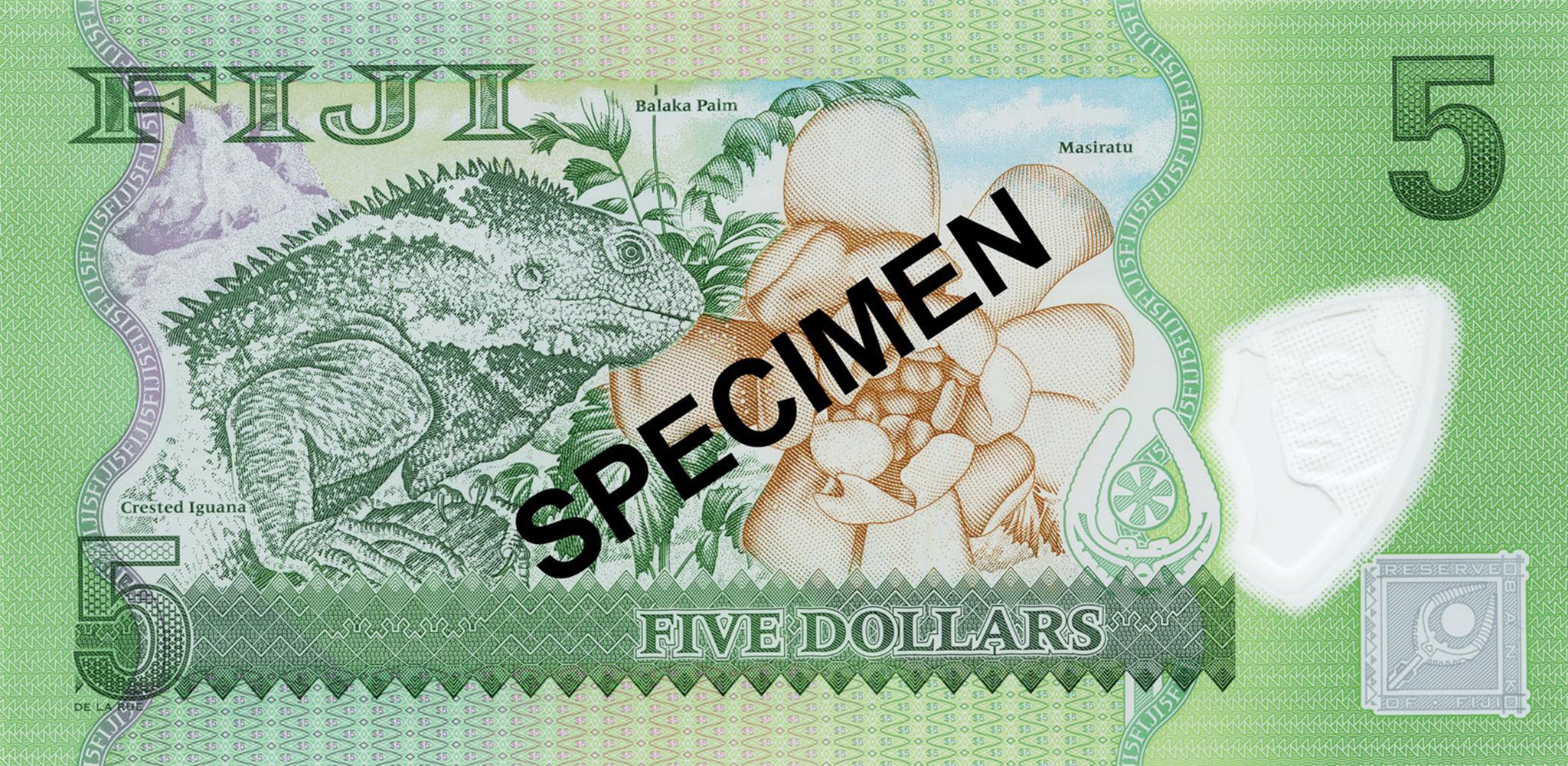
$10-Purple Size: 141 X 67mm Paper Banknote
Front design features Fiji’s endemic Beli (Lever’s Goby). Beli is one of few true freshwater fish, living all its life in fast-running fresh water as it flows over stones to which they often attach. Beli are widespread and found in mid reaches of clear streams on all the high islands, sometimes over a hundred metres above sea level. They are generally absent from muddy water and are threatened by alteration in either water flow or water quality.
Their presence in any river is an indicator of good habitat quality and minimal catchment disturbance. An image of i Buburau-ni-bete (duck dish) is also featured on the front. Back design features the Grand Pacific Hotel in Suva in 1914 and the Joske’s Thumb in the background.
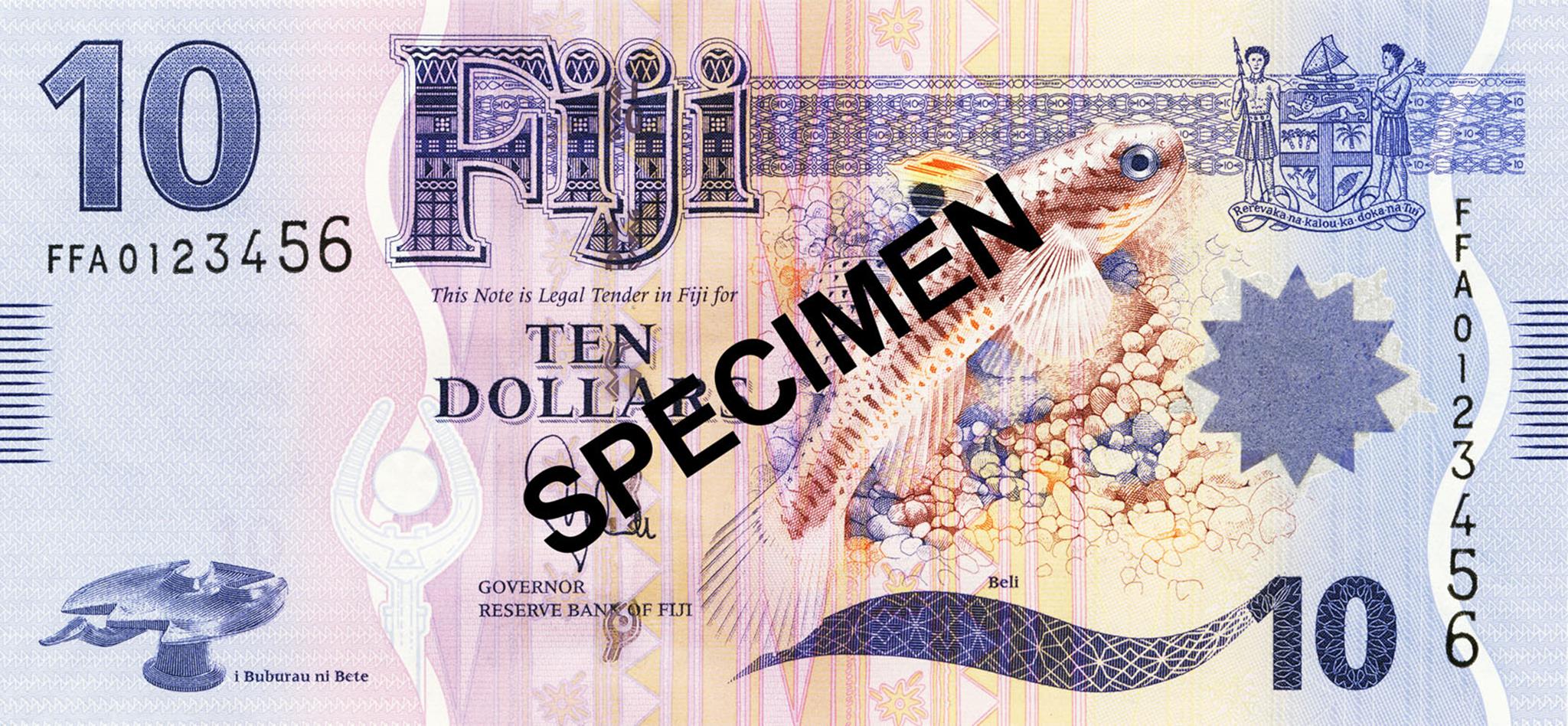

$20-BlueSize: 146 x 67mm Paper Banknote
Front design features one of the world’s iconic rare birds, the Kacau ni Gau(Fiji Petrel) which is known to nest only on Gau Island in Fiji. Experts believe that no more than 50 pairs survive. For much of its life, the Kacau ni Gau is a true ocean bird and remains at sea probably well outside Fijian waters for months on end. Adults return to Gau only to breed in a burrow in the upland forests, and do so only at night and leave for the ocean before dawn.
The Kacau ni Gau is almost never seen on the island, except when individuals are blinded by light and become grounded in villages. Research over many years has failed to find the nesting sites but this activity is continuing. The Kacau ni Gau has a very distinctive flight style which helps to make it stand out.An image of a Foa (Rotuman coconut scraper) is also featured on the front. Back design features fishing, forestry, sugarcane and mining industries of Fiji. Mount Uluinabukelevu in Kadavu is also featured in the background

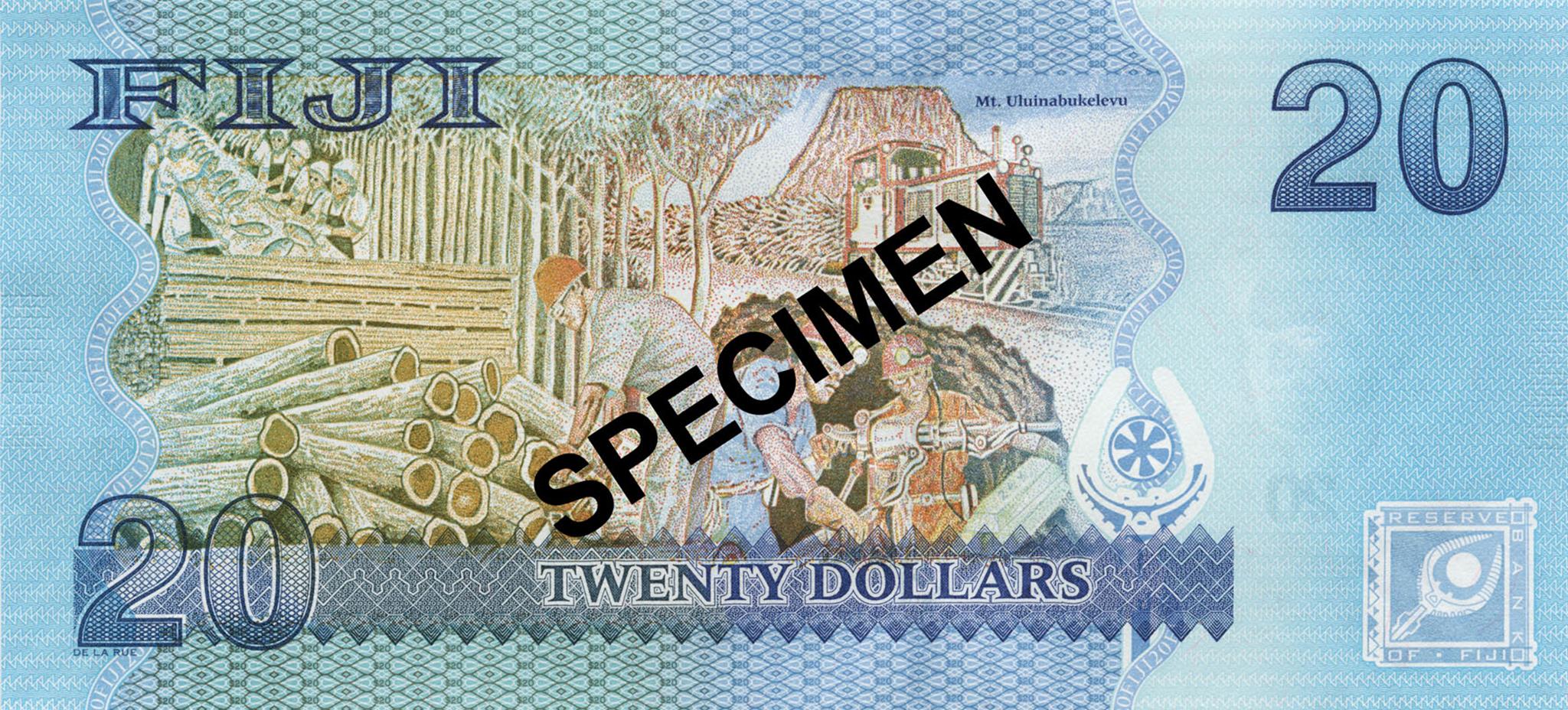
$50-Orange Size: 151 x 67mm Paper Banknote
Front design features the Tagimoucia (Medinella waterhousei) flower which is perhaps Fiji’s best known flower and has, in the past, been recommended as the national flower. It is the subject of songs, stories and folk lore. Tagimoucia is a liana of the upland forest and where it occurs it often flowers profusely in bunches of vivid scarlet petals contrasting with the pure white centres.
The name Tagimoucia is synonymous with the plant in its home in upland Taveuni around the lake with the same name, but Medinella waterhousei also occurs on Mount Seatura in Bua.An image of a Wasekaseka (Whale’s tooth necklace) is also featured on the front. Back design features a culture and heritage theme with descriptions of a traditional Tabua and Yaqona Vakaturaga ceremony.
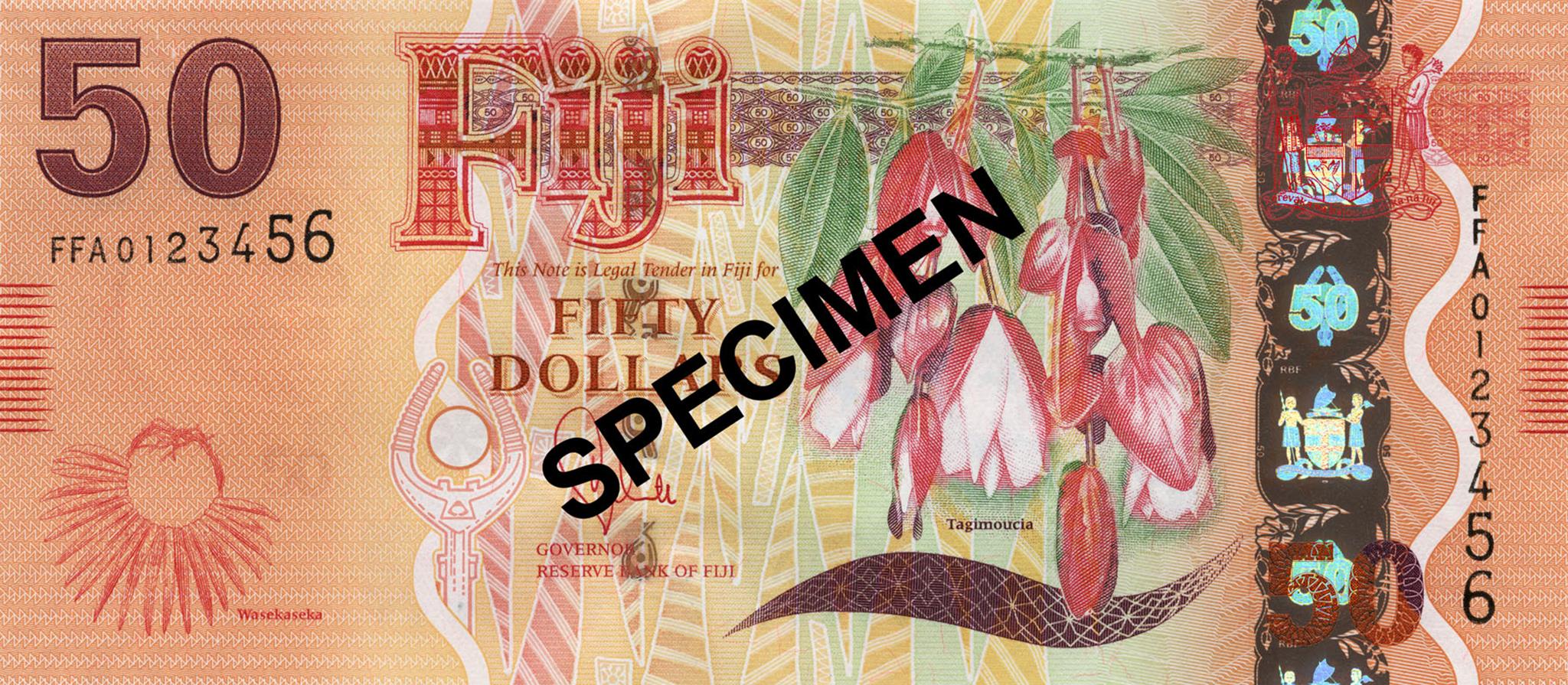

$100-Yellow Size: 156 x 67mm Paper Banknote
Front design features Fiji’s Nanai (Cicada). Fiji has the richest fauna of cicadas in the south west Pacific with 19 species, all of which are endemic. Cicadas are well known for their loud calls, some of which resound through Fiji’s forests. Larval cicadas live underground and feed on the sap from roots of forest trees. They then emerge, shed their larval skins and enjoy a short, noisy adult life in Fiji’s forests.
Maka is the common Fijian name for cicadas in general, but the Nanai is unique due to its striking appearance. Nanai is extremely well known to the inland communities of Viti Levu as it emerges in enormous numbers once every eight years and is not otherwise seen.An image of a Buli kula (Golden Cowrie) is also featured on the front.Back design features the map of Fiji with 180º Meridian Line marking the dawn of a new day, smiling faces representing Fiji’s friendliness, a cruise boat for island hopping and tourists snorkelling.


Polymer Clear Window ($5 only)
Hold the note up against the light to see the clear window with an outline of an i-Taukei man

Watermark ($10, $20, $50 and $100 only)
Hold the note up against the light to see an outline (Watermark) of an i–taukei man appearing on the front left hand side of the note.

See-through Feature
Hold the note up against the light and you will find that the white circle inside the RBF logo tagaga on the front of the note is neatly filled in with the patterns on the back of the note.

Security Threads ($10, $20, $50 and $100 only)
When viewed under normal light, the thread will appear as metallic dashes. Hold the note up against the light and you will find the thread appearing as a continuous line with the letters “RBF”, RBF logo tagaga and the denominational numeral clearly written on the thread.

Hidden Text ($10, $20, $50 and $100 only)
Tilt the note at an angle to see the word “FIJI” on these notes

Foil ($10 only)
Features a foil with a star printed over it. Tilt the note to see a movement inside the star.

Hologram ($20 only)
Tilt the note at different angles to see the image of the bird Kacau ni Gau, letters “RBF”, RBF logo tagaga and the number 20 inside the hologram. You will also be able to see different colours in the hologram as and when you tilt the note.
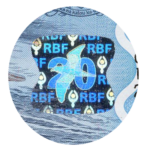
Holographic Stripes ($50 and $100 only)
Tilt the note at different angles to see the Fiji Coat of Arms, the letters “RBF”, RBF logo tagaga, the denominational numeral and flora & fauna design decorations. You will also find that the thread displays bright colours as and when the note is tilted.

Colour Changing Thread ($100 only)
Tilt the note at different angles and you will find that the new 4mm thread changes colour from red to green.
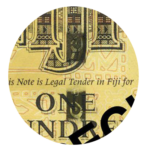
Raised Intaglio Bars ($10, $20, $50 and $100 only)
The left and right edges on the front of these notes have raised line prints. Fold the note so that you can rub the two edges together. You will find that when the edges are rubbed together, the raised line prints will grind against each other and give a crackling feel.

Raised Print ($10, $20, $50 and $100 only)
Run your finger across the front of the note and you will feel raised print across the front of the note.
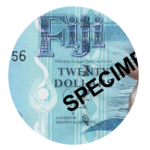
5 cents
Diameter: 19.50mm
Weight: 2.34 grams
Thickness: 1.20mm
Shape: Round
Edge: Smooth
New front design features a Nuqa-roro (Bi-colour Foxface Rabbitfish). Discovered in Fiji waters, this distinctive species was named in 1974 after the University of the South Pacific – uspi. It has since been found from Tonga to New Caledonia but remains relatively uncommon throughout its range. Nuqa-roro is an algal feeder and is sought after by the aquarium trade.
Hover to back of the coin.
Back design features a Lali (drum).

10 cents
Diameter: 21.50mm
Weight: 3.55 grams
Thickness: 1.50mm
Shape: Round
Edge: Milled
New front design features a Beka-Mirimiri, (Fiji Flying Fox) which is one of the world’s rarest mammals. It has only ever been recorded for certain on three occasions – most recently in 2009 by a team from NatureFiji-MareqetiViti, [a fully local environment NGO] and on all occasions in the upland cloud forests of Taveuni, at elevations near or higher than 1,000 metres. The Fiji Flying Fox is a very distinctive species with no close relatives. Because of its rarity, nothing is known of its behaviour and ecology.
Hover to back of the coin.
Back design features an I ulã tavatava (throwing club).
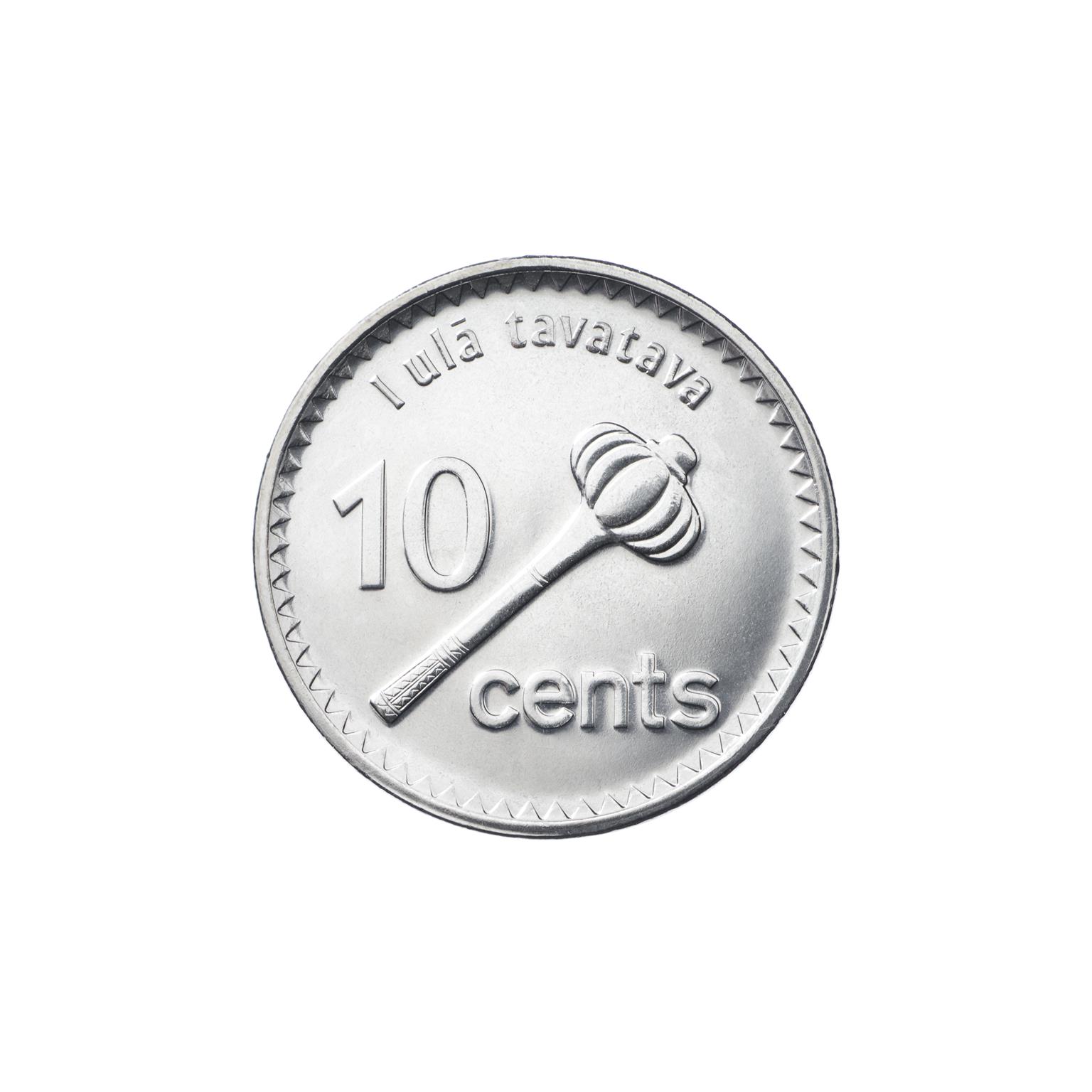
20 cents
Diameter: 24.00mm
Weight: 4.68 grams
Thickness: 1.60mm
Shape: Round
Edge: Mixed (Smooth and Milled)
New front design features a Kakã (Kadavu Shining Parrot). Fiji’s shining parrots are a strikingly beautiful group of two to six varieties. The most distinct of them is the Kakã or Kadavu variety which is generally accepted as a full species. While the red of the other varieties is a subdued darkish red varying to a deep burgundy, the underparts of Kadavu’s parrots are a bright scarlet or crimson. Kadavu parrots also display a bright blue patch on the back at the base of their necks. Formerly, the red feathers of Fiji’s parrots were central to an almost Pacific-wide trade, in fact they were the currency of trade for many of the Pacific’s earliest inhabitants. Despite this and the advent of modern science we currently know next to nothing about the status, ecology and behaviour of the Kadavu parrot or its relatives in Fiji.
Hover to back of the coin.
Back design features a Camakau (traditional outrigger canoe)

50 cents
Diameter: 26.50mm
Weight: 6.50 grams
Thickness: 1.80mm
Shape: Round
Edge: Milled
Front design features a Varivoce (Humphead Wrasse), one of the largest reef fishes in the world earning its name from the prominent hump that develops on the forehead of mature individuals. Adults are generally solitary and spend the day foraging on the reef, using their tough teeth to consume hard-shelled species such as molluscs, echino-derms and crustaceans. Varivoce are extremely long-lived, known to survive for at least 30 years, and taking around five to seven years to reach sexual maturity. Although now protected in Fiji, the flesh of this fish is highly prized and it remains one of the most highly sought species.Source: www.arkive.org
Hover to back of the coin.
Back design features a Camakau (traditional outrigger canoe)

$1
Diameter: 23.00mm
Weight: 5.05 grams
Thickness: 1.80mm
Shape: Round
Edge: Milled
New front design features a Vokai (Banded Iguana), found on many islands of the Lau group. Banded iguanas are extremely well camouflaged and cryptic in nature and so are very rarely seen. They are at risk to predation by rats and feral cats on most islands and the mongoose causes the extirpation of iguanas wherever it is present. Recent genetic work on Fiji’s three species of iguana show that each island population differs genetically and so all need to be conserved as distinctive populations.
Hover to back of the coin.
Back design features a Saqãmoli (drinking vessel)

New $2 coin
Diameter: 26mm
Weight: 7.85 grams
Thickness: 2.25mm
Shape: Round
Edge: Spanish Flower
Metal Composition: Bronze plated steel
New front design features a Ga ni Vatu (Peregrine Falcon). The Peregrine Falcon is one of the world’s best known ‘birds of prey’. Fiji has a distinctive subspecies – nesiotes – or ‘the islander’. This subspecies is the darkest and according to many, the most handsome of all the Peregrines worldwide. For Fijians, the Ga ni vatu has a powerful mystique which stems perhaps from a now largely forgotten legend of a fabulous Ga ni vatu from the Yasawa Islands. In Fiji, the population of the Ga ni vatu is less than a hundred pairs and is believed to be declining
Hover to back of the coin.
Back design features a Tanoa (kava bowl) introduced in the 1700s, and which came into widespread use in the mid nineteenth century.


